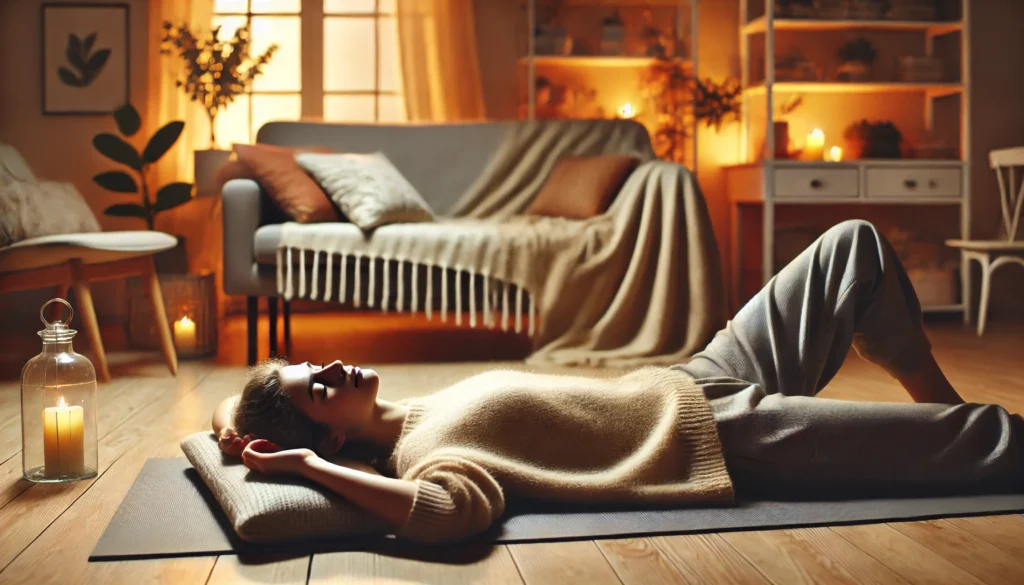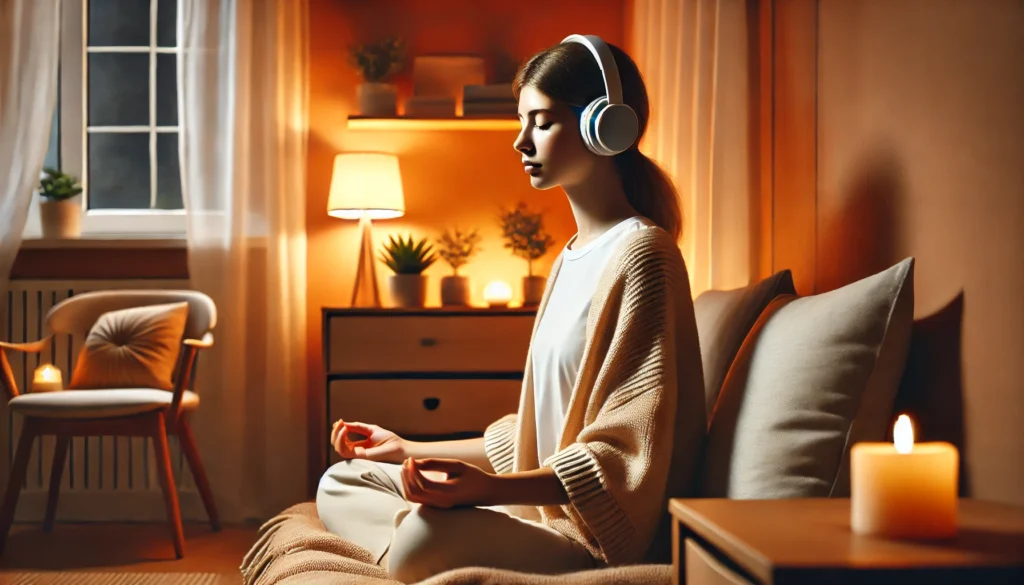This article delves into effective relaxation techniques, providing a comprehensive overview of methods supported by scientific research. Whether you’re a health and wellness coach seeking valuable resources for clients, a science journalist looking to articulate intricate health information, or a biohacker aiming to enhance mental acuity, these insights offer practical advice and informed context.
You may also like: Natural Supplements for Effective Anxiety Relief

Understanding Anxiety: A Brief Overview
Before exploring relaxation techniques, it’s essential to understand anxiety itself. Anxiety is a natural response to stress, characterized by feelings of worry, nervousness, or fear. While occasional anxiety is a normal part of life, chronic anxiety can interfere with daily activities and overall well-being.
The Science of Anxiety
Anxiety triggers the body’s fight-or-flight response, releasing stress hormones like cortisol and adrenaline. This physiological reaction prepares the body to respond to perceived threats. However, when anxiety is chronic, it can lead to a host of physical and mental health issues, including insomnia, muscle tension, and impaired concentration.
Types of Anxiety Disorders
Anxiety manifests in various forms, including generalized anxiety disorder (GAD), panic disorder, and social anxiety disorder. Each type has distinct characteristics and impacts individuals differently. Understanding these differences is crucial for tailoring effective relaxation techniques and therapeutic interventions.
The Impact of Anxiety on Daily Life
Chronic anxiety can significantly affect day-to-day functioning, influencing work performance, relationships, and overall quality of life. Individuals may experience constant worry, fatigue, and difficulty concentrating. Recognizing these symptoms early can help in seeking appropriate interventions and adopting effective relaxation strategies.
The Role of Meditation in Anxiety Relief
Meditation, a practice that dates back thousands of years, has been shown to significantly reduce anxiety. It involves focusing the mind on a particular object, thought, or activity, fostering a state of mental clarity and emotional calm.
Free Guided Meditation for Stress and Anxiety
Guided meditation is a popular form of meditation that involves a narrator leading you through a calming journey. These sessions often incorporate visualization techniques and soothing music, making them accessible even for beginners. Numerous online platforms offer free guided meditation sessions specifically designed to alleviate stress and anxiety.
Benefits of Guided Meditation
Guided meditation offers the advantage of structure, making it easier for beginners to follow along. The use of calming narratives and music can enhance the relaxation experience. This method provides a gentle introduction to meditation practices, helping individuals gradually build their confidence and skill.
Popular Platforms for Guided Meditation
Various platforms offer guided meditation sessions tailored for anxiety relief, such as Headspace, Calm, and Insight Timer. These resources provide diverse meditation styles and lengths, catering to individual preferences and schedules. Exploring these platforms can help users find sessions that resonate with them.
How to Maximize the Benefits of Guided Meditation
To fully benefit from guided meditation, consistency is key. Regular practice can enhance the ability to enter a relaxed state more quickly. Creating a dedicated space and time for meditation can also promote a more profound and lasting impact on anxiety levels.
Stress Meditation Guided Practices
Guided meditation practices focus on redirecting attention from anxiety-inducing thoughts to the present moment. Techniques often include deep breathing exercises, progressive muscle relaxation, and mindfulness meditation. By regularly practicing these techniques, individuals can cultivate a sense of peace and resilience against stressors.
Deep Breathing Techniques
Deep breathing exercises are a cornerstone of stress meditation, promoting relaxation and oxygenating the brain. Techniques such as diaphragmatic breathing or the 4-7-8 method can reduce heart rate and lower stress levels. These exercises are simple, effective, and can be practiced anywhere.
Progressive Muscle Relaxation
Progressive muscle relaxation involves tensing and then relaxing muscle groups, which can alleviate physical tension associated with anxiety. This practice increases body awareness and helps individuals identify areas of stress. It is particularly useful for those who experience somatic symptoms like headaches or muscle tightness.
Mindfulness Meditation Practices
Mindfulness meditation emphasizes being present without judgment, helping to break the cycle of anxious thinking. Practices like body scans or mindful breathing foster awareness and acceptance of current experiences. Regular mindfulness meditation can improve emotional regulation, increasing resilience to stress.
Meditation for Worry Reduction
Meditation can effectively diminish worry by fostering an awareness of the present moment. Practices such as mindful breathing and body scans encourage individuals to observe their thoughts and feelings without judgment. This awareness helps break the cycle of chronic worrying, promoting a more balanced mental state.
Understanding the Cycle of Worry
Worry often stems from an attempt to control uncertain future outcomes, leading to a cycle of anxiety. Meditation practices encourage acceptance of uncertainty, helping to disrupt this cycle. By focusing on the present, individuals can reduce the mental clutter that fuels chronic worry.
Techniques for Cultivating Present-Moment Awareness
To cultivate present-moment awareness, individuals can engage in practices like mindful walking or journaling. These activities encourage focusing attention on the here and now. Regular engagement with these practices can help shift focus away from future uncertainties and towards current experiences.
Overcoming Barriers to Meditation
Many individuals face challenges when beginning a meditation practice, such as restlessness or difficulty focusing. Understanding these barriers and developing strategies, such as starting with shorter sessions or using guided meditations, can enhance success. Patience and persistence are vital for establishing a sustainable meditation routine.

Relaxation Meditation for Anxiety: Techniques and Benefits
Relaxation meditation encompasses a variety of techniques designed to induce a state of relaxation, thereby reducing anxiety. Each technique offers unique benefits, allowing individuals to tailor their practice to their specific needs.
Progressive Muscle Relaxation
This technique involves systematically tensing and relaxing different muscle groups. By doing so, individuals become more aware of physical sensations, helping to alleviate tension and promote relaxation. Progressive muscle relaxation is particularly beneficial for those experiencing physical symptoms of anxiety, such as muscle tightness or tension headaches.
Step-by-Step Guide to Progressive Muscle Relaxation
A step-by-step approach to progressive muscle relaxation includes starting from the toes and working up to the head. By consciously tensing and releasing each muscle group, individuals can enhance body awareness. This systematic relaxation can significantly reduce overall tension and promote a sense of calm.
Benefits for Physical and Mental Health
Progressive muscle relaxation not only reduces anxiety but also improves sleep quality and lowers blood pressure. The practice can enhance mental clarity and focus by reducing physical discomfort. Its benefits extend beyond anxiety, contributing to overall well-being.
Integrating Into Daily Routine
Incorporating progressive muscle relaxation into a daily routine can be as simple as setting aside five minutes each day. Practicing before bedtime can promote better sleep, while a morning session can start the day with calmness. Regularity enhances its efficacy in managing anxiety symptoms.
Visualization and Guided Imagery
Visualization involves creating mental images of peaceful, calming settings. Guided imagery takes this a step further by incorporating a narrative to guide the visualization process. This technique can help redirect focus away from stressors, providing a mental escape and reducing anxiety.
The Power of Mental Imagery
Mental imagery taps into the brain’s natural ability to simulate experiences, creating a calming effect. By imagining serene landscapes or positive outcomes, individuals can shift their mental state. This practice can enhance emotional resilience by reinforcing positive mental associations.
Techniques for Effective Visualization
Effective visualization involves engaging all senses to create a vivid mental picture. Techniques can include imagining the sights, sounds, and smells of a calming environment. Practicing regularly can enhance the ability to quickly access these mental retreats during stressful times.
Applications in Stress and Anxiety Management
Guided imagery is used in various therapeutic contexts, including pain management and performance enhancement. Its application in anxiety management is supported by evidence showing reduced stress hormone levels. Incorporating guided imagery into a relaxation routine can enhance overall mental well-being.
Mindfulness Meditation
Mindfulness meditation involves paying attention to the present moment without judgment. This practice helps individuals become more aware of their thoughts and feelings, reducing the power of anxiety-inducing thoughts. Regular mindfulness meditation practice has been shown to improve emotional regulation and decrease anxiety symptoms.
Foundational Mindfulness Practices
Foundational practices include mindful breathing, body scans, and mindful observation of thoughts. These techniques cultivate awareness and acceptance, reducing the impact of negative thought patterns. Over time, mindfulness practice can lead to significant improvements in emotional health.
Long-Term Benefits of Mindfulness
The benefits of mindfulness extend beyond immediate stress relief, contributing to long-term mental health. Regular practice has been linked to decreased symptoms of depression and improved cognitive function. Mindfulness enhances the ability to respond to stress with greater equanimity.
Integrating Mindfulness Into Everyday Life
Mindfulness can be integrated into daily activities, such as eating or walking, to enhance present-moment awareness. Practicing mindfulness in everyday contexts reinforces its principles and strengthens its impact. Simple practices, like pausing to take a few mindful breaths, can make a significant difference in daily stress levels.
Historical Context and Current Trends in Meditation
Meditation has a rich history, with roots in ancient Eastern traditions such as Buddhism and Hinduism. Over the centuries, it has evolved and been adapted by various cultures worldwide. Today, meditation is embraced by Western science and medicine as a viable complementary therapy for anxiety and stress.
The Evolution of Meditation Practices
Meditation practices have evolved from religious and spiritual origins to secular applications. This evolution reflects a growing understanding of meditation’s universal benefits. Modern adaptations have made meditation accessible to diverse populations, promoting mental and emotional health.
Scientific Acceptance and Validation
The scientific community has increasingly recognized meditation’s benefits, leading to numerous studies and research initiatives. Evidence supports its role in reducing anxiety, improving cognitive function, and enhancing overall well-being. This acceptance has fueled interest in meditation as a complementary health approach.
Global Trends and Adaptations
Globally, meditation practices are adapting to cultural contexts, leading to innovative approaches. From digital meditation apps to corporate wellness programs, meditation is being integrated into various aspects of modern life. These trends reflect a growing recognition of meditation’s versatility and efficacy.
Future Implications of Meditation Practices
As interest in meditation continues to grow, research into its benefits and mechanisms is expanding. Future studies may further elucidate how meditation influences brain function, potentially leading to more targeted interventions for anxiety and other mental health conditions.
Emerging Research Areas
Emerging research is exploring meditation’s effects on neuroplasticity and emotional regulation. Understanding these mechanisms could inform new therapeutic approaches. Continued investigation may unlock additional health benefits and applications for meditation.
Potential for Personalized Meditation Programs
Advancements in technology may lead to personalized meditation programs tailored to individual needs. Biofeedback and AI could enhance these programs’ effectiveness by providing real-time insights. Personalized approaches could optimize meditation’s impact on mental health.
The Role of Meditation in Public Health
Meditation’s potential as a public health tool is gaining recognition. Its accessibility and low cost make it an attractive option for widespread implementation. Public health initiatives incorporating meditation could improve community well-being and reduce healthcare costs.
Practical Advice for Implementing Relaxation Techniques
For those new to relaxation techniques, starting with short, guided sessions can be particularly beneficial. As proficiency develops, individuals can explore different practices and find what resonates most with them. Consistency is key; regular practice enhances the efficacy of these techniques in managing anxiety.
Creating a Relaxation Routine
To incorporate relaxation techniques into daily life, consider setting aside a specific time each day for practice. This routine can be as short as five minutes or as long as an hour, depending on individual preferences and schedules. Establishing a calm, distraction-free environment can enhance the effectiveness of the practice.
Designing a Personalized Routine
Creating a personalized routine involves selecting techniques that align with individual goals and lifestyle. Flexibility in routine design can accommodate changing needs and schedules. A well-structured routine can increase adherence and maximize the benefits of relaxation practices.
Overcoming Common Challenges
Common challenges in establishing a routine include time constraints and lack of motivation. Identifying these obstacles and developing strategies, such as setting reminders or joining a group, can support consistency. Persistence in overcoming challenges enhances the likelihood of routine success.
Measuring Progress and Adjusting Practices
Regularly assessing the impact of relaxation techniques can guide adjustments to practices. Keeping a journal or using tracking apps can provide insights into progress and areas for improvement. Adapting practices to reflect personal growth and changing needs ensures continued effectiveness.
Utilizing Technology and Resources
Numerous apps and online platforms offer access to guided meditation and relaxation resources. These tools can provide structure and support, making it easier to maintain a regular practice. Additionally, many of these resources are free or low-cost, making them accessible to a wide audience.
Exploring Digital Resources
Digital resources offer a wealth of guided sessions, educational content, and community support. Platforms like Calm, Insight Timer, and YouTube provide diverse options for users at all experience levels. Exploring these resources can enhance understanding and practice of relaxation techniques.
Benefits of Technology-Assisted Relaxation
Technology-assisted relaxation offers convenience and accessibility, supporting consistent practice. Features such as reminders, progress tracking, and community forums enhance engagement. Leveraging technology can make relaxation practices more integrated into daily life.
Finding the Right Tools for You
Finding the right digital tools involves exploring different platforms and assessing their alignment with personal goals. Consider factors such as user interface, content variety, and community features. Selecting tools that resonate with individual preferences can enhance practice sustainability.

Conclusion
Relaxation techniques offer a powerful means of managing anxiety, backed by scientific research and centuries of practice. By incorporating meditation, mindfulness, and other relaxation practices into daily life, individuals can cultivate a sense of calm, resilience, and well-being. Whether you’re guiding clients, writing for the public, or optimizing your own mental health, these techniques provide valuable tools for anxiety relief. As our understanding of these practices continues to grow, their role in promoting mental health and well-being will undoubtedly become even more integral.
Further Reading:
Exploring the Benefits of Meditation for Anxiety
How to use meditation for anxiety: 12 tips & techniques
Guided Sleep Meditation: Let Go of Anxiety & Calm Your Mind
Important Note: The information contained in this article is for general informational purposes only, and should not be construed as health or medical advice, nor is it intended to diagnose, prevent, treat, or cure any disease or health condition. Before embarking on any diet, fitness regimen, or program of nutritional supplementation, it is advisable to consult your healthcare professional in order to determine its safety and probable efficacy in terms of your individual state of health.
Regarding Nutritional Supplements Or Other Non-Prescription Health Products: If any nutritional supplements or other non-prescription health products are mentioned in the foregoing article, any claims or statements made about them have not been evaluated by the U.S. Food and Drug Administration, and such nutritional supplements or other health products are not intended to diagnose, treat, cure, or prevent any disease.


